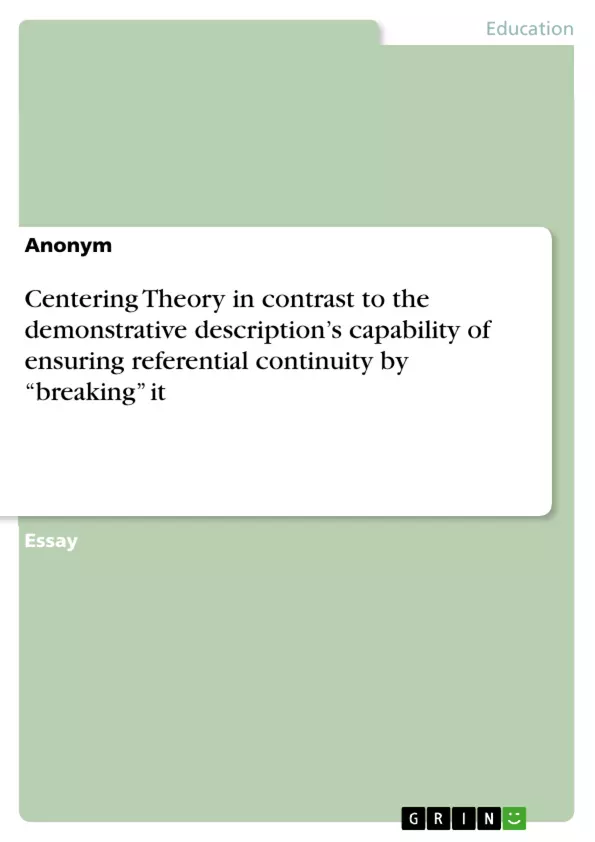Comparing the apparent contrasting statements of Centering Theory and Fossard, Garnham and Cowles (2012) in regards to demonstrative descriptions, I particularly examined reference resolution as an influencing factor of text coherence. According to the results of Fossard et al. (2012), the reference resolution of demonstrative descriptions was only facilitated when the predicative information referred to the subordinate character in a gender-ambiguous condition. As demonstrative descriptions have an exceptional discourse function due to their anadeictic dimension, they are capable of ensuring unexpected referential continuity by marking a discontinuity with the previous context. In regards to Centering Theory, however, a discourse is more coherent if utterances preserve the same topic and keep it as the highest-focused entity without diminishing its relative ranking. This continue transition state is considered most preferable. While demonstrative descriptions serve in an unexpected and unique way, their exceptionality seems to be beyond the Centering Theory’s stated preferences for text coherence and hence not against it.
Inhaltsverzeichnis (Table of Contents)
- Abstract
- Introduction
- Centering Theory in contrast to the demonstrative description's capability of ensuring unexpected referential continuity
- The resolution of demonstrative descriptions in correlation to referential continuity
- Centering Theory
- The fundamentals of Centering Theory
- An analysis of this-NPs
- Is there a contradiction between Centering Theory and the anadeictic value of demonstratives to ensure referential continuity by “breaking\" it?
- Conclusion
- References
Zielsetzung und Themenschwerpunkte (Objectives and Key Themes)
This paper examines the apparent contrasting statements of Centering Theory and Fossard, Garnham and Cowles (2012) regarding demonstrative descriptions, focusing on reference resolution as an influencing factor of text coherence. It investigates whether there is a contradiction between these two approaches, particularly considering the ability of demonstrative descriptions to ensure unexpected referential continuity.
- Reference resolution and its impact on text coherence
- The discourse function of demonstrative descriptions
- Centering Theory and its principles for text coherence
- The anadeictic value of demonstratives and their role in referential continuity
- The relationship between Centering Theory and the unexpected referential continuity facilitated by demonstratives
Zusammenfassung der Kapitel (Chapter Summaries)
The first chapter provides a concise overview of the research question and the theoretical frameworks involved. It highlights the contrasting perspectives of Centering Theory and Fossard et al. (2012) regarding demonstrative descriptions and referential continuity.
The second chapter introduces the concept of text cohesion and the role of linguistic theories in understanding how readers perceive text coherence. It then focuses on the study of Fossard et al. (2012) and its investigation of the discourse function of demonstrative descriptions in creating referential continuity.
Chapter three delves into the details of Centering Theory, explaining its fundamentals and its focus on maintaining topic continuity. It also includes an analysis of demonstrative expressions based on the work of Poesio (2008).
Schlüsselwörter (Keywords)
This paper examines the interplay between Centering Theory, reference resolution, and the discourse function of demonstrative descriptions. It explores the concepts of text coherence, anaphora, deixis, anadeixis, referential continuity, and the role of salience and gender agreement in anaphor processing.
- Quote paper
- Anonym (Author), 2016, Centering Theory in contrast to the demonstrative description’s capability of ensuring referential continuity by “breaking” it, Munich, GRIN Verlag, https://www.hausarbeiten.de/document/385992


